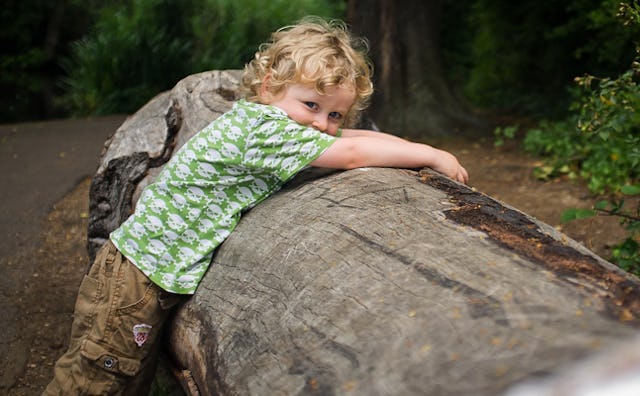My Imperfect Child

The weather was exquisite today. A breezy 65 with the sky a dizzying, unblemished blue. I set out with our wide red wagon, a cadre of sippy cups and snacks, and my two children, a boy and a girl. Just turned three and almost two; highly sensitive and sassy, respectively. And I herded them into the car to drive to the zoo—along with about 500 others also taking advantage of the weather.
As my almost two year old enjoyed the leisurely wagon ride, my son strode purposefully toward each of the animal’s enclosures, peering through the fences.
Just a day ago, he was a shrinking violet, clinging to my leg as we walked the halls of the occupational therapist’s office. We were there to get a screening after his well-meaning Mother’s Day Out teachers informed us they thought he wasn’t ready for preschool.
You see, my son, the one whose honey-colored eyes sparkle when he sees tigers and lions and giraffes, is highly sensitive and often babyish.
He turned three just two months ago. And at home, his first line of defense when something doesn’t go his way—whether it’s a cookie that fell or the way his sister looks at him—is often whining or crying.
At school, though, he makes me lean in for a hug, promise I’ll be back to get him after lunch, and goes in. He’s the quiet child who never cries, never takes toys from others. He mingles with the other kids, but he’s really there for the train tables, the playground, the books.
And when they have circle time at Mother’s Day Out and he’s called upon to stand up and be singled out, his whole body recoils. Here, at school, he folds into himself. It’s quite the transformation—a butterfly shrinking back into a caterpillar. Simply, he shuts down. His muscles tense beneath his Gymboree shirt and his mouth goes slack, creating a downturned effect.
One day, I went to observe this circle time.
“Come up here,” a teacher says gently.
He stays frozen, perhaps hoping if he’s still enough he’ll be passed by.
“Stand up,” the teacher prompts. “Okay, now walk over here.”
He does this, slowly, pathetically. Charlie-Brown-like in his saunter.
“Can you pick out the yellow triangle and put it on the board?”
Frozen again.
I am observing this classroom activity, or lack thereof, just out of sight. I nervously bite a hangnail, afraid that if I let my teeth off that flap of skin, I’ll yell out: “For the love of God, you know this! Just pick it up and do it. Do it!”
But I stand helpless, helpless. “Just do it. Do it. You know this!” I’m mentally chanting.
Frozen again. (Maybe that’s why the eponymous Disney movie is his favorite.)
“Okay,” the teacher begins prompting again. “Lean down and pick up the shape.”
Slowly, robotically, he obliges.
“Okay, now put it on the board.”
He’s gone again. Looking at the board, but his feet seem glued to the ground.
“Walk over there and put it on the board. Right there. No, there,” the teacher instructs.
He finally does and then continues standing.
“Move it!,” I will him.
“Okay, now go sit back down in your place,” his teacher intones.
He does so, his posture slumping. I can see he’s more relaxed. The pressure is moving to someone else.
I know my child. I spend all but eight hours a week without him. Those eight hours are spent at the Mother’s Day Out. The teachers don’t see him cry, they don’t see how exceedingly shy and sensitive my son is. They don’t realize just how much he shuns attention. He still clings to vestiges of babyishness in part because a baby sister a mere 16 months younger robbed him of some of the extra attention he perhaps needed. But, he also takes longer to do things because he is himself.
So, to occupational therapy we go. Just for an unbiased review.
In the therapist’s office, after I pry him off my leg, I coax my son into a little chair. The therapist has kind eyes and a soothing voice. She hands him a crayon and asks him to color. He, a left-handed child, takes the crayon in his right hand, nervously puts his left arm over his forehead and begins pathetically dotting at the illustrations on the page.
Here I am, watching him again. Another place, another room, still freezing up. This time, I’m sitting right next to him and biting my lip to keep from saying: “You’re doing it wrong.”
He’s given a list of activities—cutting, drawing, naming objects—many of which they say he does incorrectly.
But he’s nervous. I’m nervous.
The compassionate occupational therapist hands me a green sheet of paper, checking off all the improvements he needs to be on track with his peers. The term “mildly developmentally delayed” based on her assessment is bandied about.
“Does a just-turned three year old really need to be able to know how to use scissors?” I ask. Really?
But then there’s today. The present. And the zoo.
And my son is one among hundreds of kids, all elated over the slow-moving animals, the too-bright sunlight bouncing off the pavement, the shrill train lumbering down the tracks. Here on this perfect day, my “developmentally delayed son” looks the same as all the other children here.
Do they all have secret heartbreaks?
Because that’s what kids do to parents: Hurt their hearts.
But here, today, there’s something healing. Maybe it’s the electrifying brightness that gives me pause for optimism. Or the tree-fluttering cool breeze.
Or maybe, just maybe, it is my graham-crackery sweet little boy who freely doles out hugs and “I love you’s” and has a head of thick caramel curls whipped into a frenzy.
I don’t know what it is. But today, at least for a moment, I see it: The perfection in my clinically “imperfect” child.
This article was originally published on